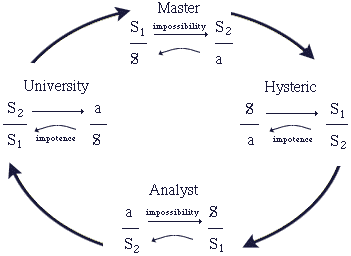An abstract for an upcoming talkfest on Lacan and the Discourse of Capitalism at Massey University in Wellington . . .
The matheme-atics of Jacques Lacan’s four — or more — discourses can enable us to account for changes in the university, and the place of dissent within (or outside) it. If, to misapply Lacan, we take the discourse of the university to represent the University 1.0 (the national university that exists to create good citizens), his fifth discourse, that of capitalism, can represent the University 2.0 (the transnational university that exists to generate transcendental, or global, capital).[1]
Both discourses, Lacan might say, serve the hidden truth of the master: the mathemes that occupy the position of agency (top left on the quadripode) are “fake masters,” to use Slavoj Žižek’s term,[2] namely,
- in the University 1.0, knowledge (S2) — or learning, embodied in the professorate, and
- in the University 2.0, the subject ($) — or consumers, including managers and academics as well as students.
The shift from a ruling discourse that produces a certain subjectivity (learning producing learned subjects) to one that is driven by a certain subjectivity (consumers producing profit) can account for changes in the university.
How are we, then, to understand the place of dissent within the university (or outside it, given that the university is now taken to be captive to and of a piece with capitalism)? The discourses of the hysteric and the analyst can be read as dissenting: the hysteric questions the hidden masters of university and capitalist discourse to protest against them;[3] the analyst works with the subjectivities that are produced in university discourse and drive capitalist discourse to transform them. But it struck me, when reading Alice and the Cheshire Cat’s ripostes to the Queen of Hearts in Lewis Carroll’s Alice’s Adventures in Wonderland (link), that I might instead construct a sixth discourse: of dissent, or dissensus, to use Jacques Rancière’s term.[4] (The Cheshire Cat hystericises and analyses the Queen; Alice dissents.)
Dissent takes the discourse of the university as its starting point, but swaps the “covert” mathemes (the bottom two mathemes) $ and S1, such that its truth becomes the subject and its product, a new kind of mastery. It is a “subjectification” of the university and a re-mastering of its universe; how so, my talk will explore.[5]
[1] Before Lacan added a fifth discourse, of capitalism (“On Psychoanalytic Discourse,” 1972/1978), he took the discourse of the university, the historical successor to the discourse of the master, to represent capitalism (The Other Side of Psychoanalysis, 1968/2007).
[2] Slavoj Žižek, Iraq: The Borrowed Kettle, 2004.
[3] For this reason, Lacan came to take the discourse of the hysteric to represent science, which offers — or ought to offer — an implicit critique of the status quo of knowledge (e.g., in Television, 1974; 1990).
[4] Jacques Rancière, “The Thinking of Dissensus: Politics and Aesthetics,” 2003.
[5] Note that Alain Badiou (Philosophy for Militants, 2012) argues by way of Lacan’s discourses for a re-mastering of philosophy: for him, philosophy has for the most part been co-opted by the discourse of the university (it has become antiphilosophy); to find its rightful place, it must re-appropriate the discourse of the master.









